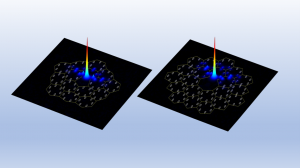Observation of nonlinear disclination states
FAYETTEVILLE, GA, USA, September 1, 2023/EINPresswire.com/ -- Controllable deformations introduced in periodic structures may lead to appearance of disclinations and open new routes for construction of higher-order topological insulators with various discrete rotational symmetries, which were observed so far only in linear regime. To break this limitation, we explored the interplay of self-action effects and topology in the disclination2 structures with different discrete rota-tional symmetries, and for the first time experimentally observed nonlinear topolog-ical dislocation states, whose localization is controlled by their power.
Higher-order topological insulators are unusual materials that can support topologically protected states. Recently discovered disclination states also belong to the class of higher-order topological states but are bound to the boundary of the disclination defect of the higher-order topological insulator and can be predicted using the bulk-disclination correspondence principle. So far, topological disclination states were observed only in the linear regime, while the interplay between nonlinearity and topology in the systems with disclinations has never been studied experimentally.
In a new paper published in Light Science & Application, a team of scientists, led by Professor Yaroslav V. Kartashov from Institute of Spectroscopy, Russian Academy of Sciences, Russia, and Professor Yiqi Zhang from Key Laboratory for Physical Electronics and Devices of the Ministry of Education & Shaanxi Key Lab of Information Photonic Technique, Xi’an Jiaotong University, China, have reported on the first experimental observation of the nonlinear photonic disclination states in waveguide arrays with pentagonal or heptagonal disclination cores inscribed in transparent optical medium using the fs-laser writing technique.
Nonlinear disclination states can be efficiently excited by Gaussian input beams when they are focused into the waveguides belonging to the disclination core of the array. Their spatial localization can be controlled by the input beam power. Corner states and edge states in these structures with disclinations are also studied. Due to the compactness of disclination states, they are beneficial for the enhancement of nonlinear effects and for realization of stable lasing. In addition, disclination lattices can be used in the design of various nonlinear topological functional devices. For example, disclination lattices may be potentially used for realisation of lasing in states with different vorticity, limited by the discrete rotational symmetry of the structure. Moreover, because in these systems disclination states coexist with topological corner states, one can potentially observe switching between lasing in these two different topological modes.
The disclination states that appear in aperiodic structures obtained due to specific deformations of periodic arrays substantially differ from previously considered higher-order insulator geometries, since systems with disclinations may have discrete rotational symmetries that are incompatible with crystalline symmetries and cannot be realized in usual higher-order insulators with periodic bulk. The study of the interplay of nonlinear effects and topology in structures with disclinations and different discrete rotational symmetries may open a new avenue for an in-depth research of the behavior and applications of higher-order topological states. These scientists summarize the findings:
“Nonlinear disclination states open new prospects for investigation of nonlinear effects in topological systems with disclinations and may inspire new ideas in developing compact optical functional devices.”
“The results are relevant for different areas of science, including Bose-Einstein and polariton condensates, where potentials with the disclinations can be created” the authors added.
###
References
DOI
10.1038/s41377-023-01235-x
Original Source URL
https://doi.org/10.1038/s41377-023-01235-x
Funding information
This work was supported by the National Natural Science Foundation of China (Grant No.: 12074308), the Fundamental Research Funds for the Central Universities (Grant No.: xzy022022058), the Russian Science Foundation grant 21-12-00096 and by the research project FFUU-2021-0003 of the Institute of Spectroscopy of the Russian Academy of Sciences, and Ministry of Science and Higher Education of the Russian Federation on the basis of the FSAEIHE SUSU (NRU) (Agreement No.: 075-15-2022-1116).
About Light: Science & Applications1
The Light: Science & Applications will primarily publish new research results in cutting-edge and emerging topics in optics and photonics, as well as covering traditional topics in optical engineering. The journal will publish original articles and reviews that are of high quality, high interest and far-reaching consequence.
Wendy Chen
TranSpread
+1 865-405-5638
email us here
1 https://www.nature.com/lsa
2 https://doi.org/10.1038/s41377-023-01235-x

